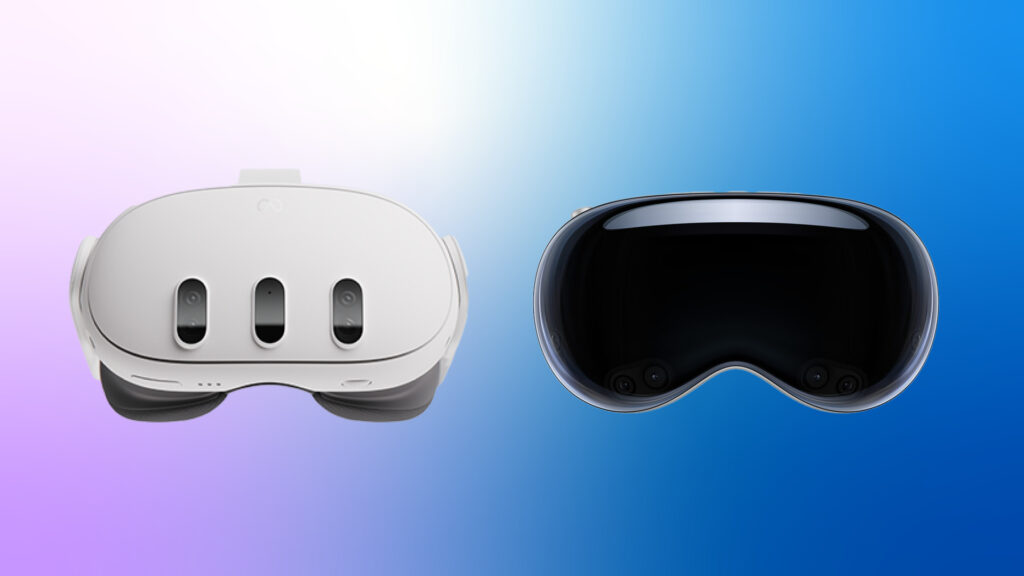Meta Quest 3 VS. Apple Vision Pro: View From Those Who Know
Share this post ▸
February 22, 2024 | Steve Grubbs (with assistance from ChatGPT)

Takeaways
- Meta Quest 3 and Apple Vision Pro have recently entered the immersive hardware market, sparking a competition between Meta and Apple for dominance.
- The Meta Quest 3, priced at $500, targets immersive gaming experiences with improved design and comfort, while the Apple Vision Pro, priced at $3,500, focuses on immersive video and movie watching with its exceptional 4K resolution screen and innovative hand and eye signal operations.
- Both headsets face challenges in broader consumer adoption due to their size, comfort, and evolving use cases, appealing mainly to specific demographics such as VR enthusiasts, gamers, students, and early adopters.
- The Quest 3 emphasizes affordability and accessibility, while the Vision Pro targets high-end consumers seeking premium experiences. Their adoption is expected to grow as technology evolves and barriers such as cost and comfort are addressed.
Our immersive learning world has been turned upside down over the last four months with the introduction of the Meta Quest 3 and the Apple Vision Pro. Two of the most successful tech companies in the world fighting for dominance in a world that is certain to be covered in immersive hardware. Meta founder and CEO, Mark Zuckerberg weighed in today with his own take. If you haven’t seen it, take a look: https://youtu.be/Q3MAAOPe2Ss?feature=shared
Now most people will conclude that Zuck has a biased view, and clearly he does. But, I don’t think he’s wrong because of that bias. Here’s how the two headsets breakdown:
Meta Quest 3: Priced at a more accessible $500, the Meta Quest 3 is a white, wireless headset that comes with handheld controllers. Meta has positioned it as an ideal device for immersive gaming experiences, a continuation of its successful Quest line. The Quest 3 is noted for its improved design over previous iterations, being smaller and more comfortable to wear, making it a significant player in the VR gaming and entertainment sphere. For those seeking an even more premium experience, Meta offers the Meta Quest Pro, a more advanced and expensive option, expanding its reach in the high-end market.
Apple Vision Pro: On the other side, the Apple Vision Pro enters the market with a hefty $3,500 price tag. This sleek headset, reminiscent of ski goggles, connects to an iPhone-sized battery pack via a wire but eschews traditional controllers for hand and eye signal operations. It has received praise for its familiar user interface and exceptional 4K resolution screen, making it unparalleled for watching immersive videos and movies. However, its high cost positions it as a luxury item beyond the reach of the average consumer.
Both headsets, despite their technological prowess, face significant challenges in terms of broader consumer adoption. The Vision Pro and Quest 3 are still relatively large, clunky, and can be uncomfortable for extended use compared to a simple pair of sunglasses. In fact, if you haven’t tried the Rayban Meta glasses yet, they may be the future of headworn computing before either of the headsets are.
Additionally, the use cases for both devices are still evolving, with current applications appealing mainly to schools, students, early adopters and tech enthusiasts.
Price and Accessibility: The Quest 3’s $500 starting price makes it a more accessible entry point into the VR world compared to the Vision Pro’s $3,500 tag. This difference in price reflects the target audience for each device, with Meta targeting a broader base of VR enthusiasts and gamers, and Apple aiming at a high-end market seeking premium experiences.
User Interface and Control: Apple’s decision to use hand and eye signals for the Vision Pro offers an innovative approach to interaction within mixed reality environments, potentially offering a more intuitive experience for navigating and consuming content. In contrast, the Quest 3’s use of handheld controllers aligns with traditional VR gaming setups, providing a familiar interface for its target audience.
Content and Use Case: The Vision Pro shines in immersive video and movie watching, thanks to its superior screen resolution and interface design. Meanwhile, the Quest 3 focuses on immersive gaming, supported by Meta’s extensive catalog of VR content and experiences.
Meta Quest 3 highlights include:
- Qualcomm Snapdragon XR2 Gen 2 chipset, offering a significant performance boost over its predecessor.
- A resolution of 2064×2208 per eye, providing sharp visuals and a reduced screen-door effect.
- Color passthrough technology for mixed reality experiences, allowing users to see the real world in color overlaid with virtual elements.
- Backward compatibility with all Quest 2 software, ensuring a broad library of games and applications from day one.
- Improved ergonomics and haptic feedback in the controllers, enhancing the user experience.
- A battery life of around 2-3 hours, depending on usage, with the battery located in the visor for a balanced design.
- Priced at $499.99 for the 128 GB model and $649.99 for the 512 GB model.
Apple Vision Pro, in contrast, offers:
- Apple’s M2 chipset, known for its power and efficiency.
- OLED microdisplays with a significantly higher pixel density than the Quest 3, promising unparalleled image quality.
- Eye tracking and face tracking capabilities, allowing for more immersive and interactive experiences.
- An external battery, providing about 2 hours of use but contributing to a lighter headset design.
- The ability to run most iPhone and iPad apps, greatly expanding its potential use cases beyond traditional VR.
- Features like OpticID for secure authentication and EyeSight for displaying notifications and information on the front of the headset.
- A starting price of $3500, reflecting its premium features and capabilities.
While both the Apple Vision Pro and Meta Quest 3 push the boundaries of what’s possible with mixed reality technology, their adoption faces hurdles related to comfort, cost, and use case specificity. For now, these devices are likely to appeal to specific use cases like education, job training, gaming and potentially, retail: the Vision Pro targeting high-end consumers looking for the ultimate immersive viewing experience, and the Quest 3 catering to VR gaming and learning enthusiasts seeking high-quality experiences at a more accessible price point. As the technology evolves and becomes more integrated into daily life, the potential for broader adoption grows, but it remains to be seen how quickly these barriers can be overcome.

Steve Grubbs is the CEO of VictoryXR, the global leader in immersive, spatial education. He is a graduate of the University of Iowa’s colleges of business and law and served in the Iowa Legislature as Chair of the House Education Committee in the early ‘90’s.








